
Fairbanks resident Jerry Evans heads for the upper Copper River each summer to exercise the salmon-harvest subsistence right every Alaskan enjoys. Though Evans mostly brings home sockeye salmon to fill his freezer for winter, here he’s hefting a 20-pound king that he hauled from the river with a net. Photo courtesy Jerry Evans
On a beautiful late summer day, Alaskan Dee Buchanon has just hauled an eight-pound salmon from a side channel on the Susitna River. The majestic fish is a perfect example of everything salmon represents in Alaska culture. It is an Expressionist masterpiece: vermilion flanks, ivory belly, platinum fins and cheeks.
Salmon are the North Pacific’s annually renewing bounty. Like all salmon, this one returned to its inland birthplace after four years at sea. Salmon has been humanity’s Northland sustenance for thousands of years, and carries a cultural meaning so indelible that Alaskans have multiple names for the same fish.
“Salmon are everything,” declares Melanie Brown, a commercial fisherman on Alaska’s Bristol Bay. “In addition to providing sustenance, salmon have been teachers. Salmon help us focus on what is important,” she adds, referring to the unending fight to preserve the state’s fisheries. “Salmon feed the world in so many ways.”
When she’s not fishing, Brown is a preservation activist. Her indigenous heritage (Yup’ik, Unangan and Iñupiaq) connects her to the 10,000-year history of salmon harvested in Alaska. Her children represent the fifth generation of her family to fish for salmon on Bristol Bay.
Close to a billion wild salmon roam the North Pacific waters bordering Alaska. Hundreds of millions of them return to the state’s rivers, streams and lakes each summer and fall to spawn and feed people, bears, eagles and the land itself. Sustaining fisheries is part of the Alaska Constitution, and the state does a good job: each year, up to 100 million salmon return to Bristol Bay, Earth’s largest remaining salmon run.
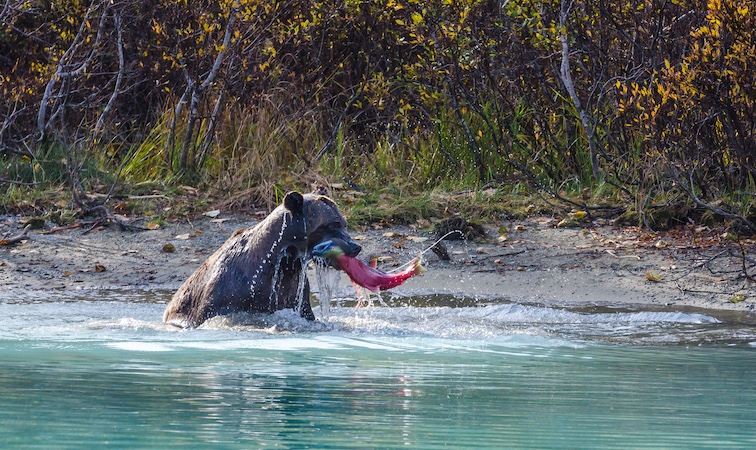
Alaska bears are as fond of salmon as people are. This coastal brown bear has just snagged a large sockeye near Redoubt Bay Lodge, a wilderness resort reached by floatplane from Anchorage’s Lake Hood seaplane base, the busiest in the world. Salmon are the reason coastal browns reach such great size, with males surpassing 10 feet and approaching 1,000 pounds. Photo by Juno Kim, Anchorage Convention & Visitors Bureau
Understanding their cultural value begins with the complex catalog of the salmonids that ply Alaska’s waters. There are five different types of salmon and each has at least two different names: King (Chinook); silver (coho); sockeye (red); pink (humpy); chum (dog, as in what sled dogs eat). All five return every summer to Alaska watersheds where they remain icons of Alaska culture.
Call of the Wild
But wait—there’s more. Add in the scientific names and those five salmon are all known three ways; sockeye/red are Oncorhynchus nerka, for instance. Some have yet another name: Sockeye are also known as blueback, for the hue along their spines when spawning, so now we’re up to four names. Kings are also spring salmon, as they are the first to return each year in some watersheds; juvenile kings are also blackmouth, so there we have one fish with five names.
Kings are the biggest (97 pounds is the record) and, for recreational anglers, most sought. Many seafood connoisseurs consider them the best, which is why king is the most expensive.
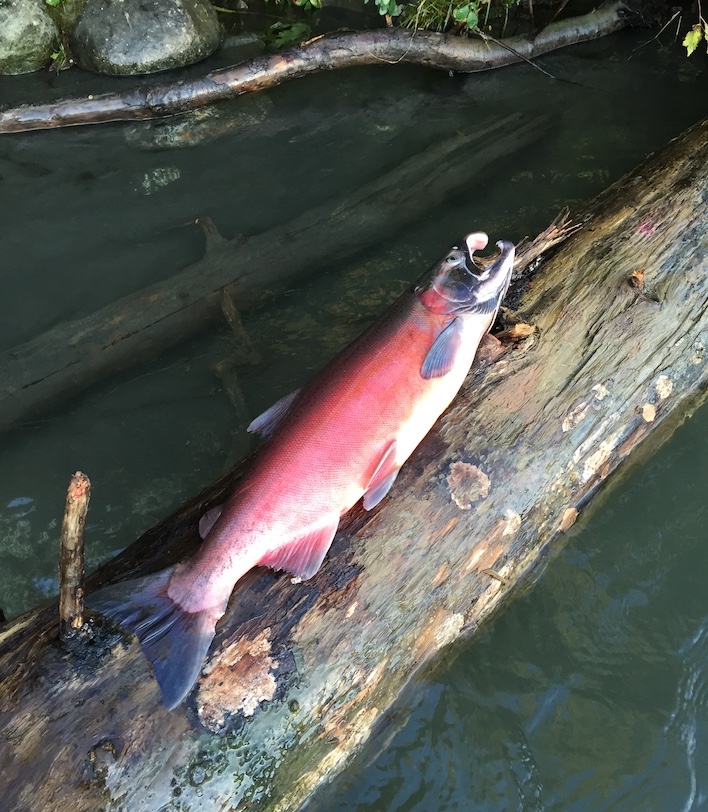
This six-pound silver salmon, caught in the Susitna River near Talkeetna, is in its late summer spawning colors. Recreational anglers often favor silvers for the dramatic fights the fish put up when hooked; though most people prefer king or sockeye to eat, silver salmon is a delectable fish. Photo by Eric Lucas
Silvers are so-called for their shimmering precious-metal sides (despite that Susitna River fish, which was in its upriver spawning finery). Sport anglers love their acrobatics when hooked—flying out of the water, diving deep, running toward Hawai’i and generally putting on a show. The state record was 26 pounds. Though almost as good-tasting as king, silver shows up far less often on menus.
Chum are large, brawny fish (32 pounds is the record) that some people look down on, but Alaska Natives have favored it for centuries for smoking. “I look for standing dead cottonwood,” Athabaskan elder Don Honea explains about his firewood preference that his ancestors have likely used for centuries. The Yukon River hosts a massive chum run, and the river’s commercial industry attempted to rebrand them as “Silverbrite” salmon to overcome their low-grade reputation. It didn’t work. Chum is relatively cheap, but simultaneously rare. They are also called dog salmon because Arctic and sub-Arctic Native peoples have fed their sled dogs chum for thousands of years. Sled dogs appreciate a fat chum.
An Unending Debate
Sockeyes are as highly regarded for their flavor as kings, and Alaskans looking to fill their freezers for winter often target reds above other species. Landlocked sockeyes that cannot reach the ocean are called kokanee; a popular Fairbanks winter activity is ice fishing for kokanee while watching the Northern Lights. Sockeye ranks just behind king in terms of reputation, popularity and price.
Pinks are the smallest (13-pound record) but most numerous, some streams so crammed with spawning fish that the water appears to be a quilt made of fish backs. Their flavor is fine but not gourmet, and deteriorates soon after harvest so they must be fresh (or flash-frozen) to taste good. I can remember a time that pink salmon were 49 cents a pound in August at Seattle markets. Today it can be five times that much.
Almost every Alaskan is familiar with this inventory, and much more. Add game meat to salmon and some Alaskans never taste beef until they leave the state to attend college in the Lower 48. Thoughtful travelers who seek to understand their destinations can embrace this universe as thoroughly as a wine tourist learns the vintages in Sonoma County.
Alaska visitors can experience all five salmon on the summertime menus of most restaurants in the state, especially in July and August. King and sockeye are common; silver is occasionally found, as is pink in late summer. Preparations for these four range from simple grilling to pan-seared with beurre blanc. I once had a sockeye filet braised in duck fat, one of the most astounding dinners of my life. The most important thing is that salmon should never be overcooked, which makes it dry and leathery. Sixty seconds too long can be ruinous.
Visitors are welcome to try out salmon fishing themselves. The best course is a day trip with a charter outfitter. The guides will clean and filet your catch, which is not a job for newbies. They can also flash-freeze and pack the fish for you to take home. These boat excursions can be either ocean or freshwater: Sitka, Ketchikan, Juneau, Seward, Whittier, Kodiak and Homer are prime ports for saltwater salmon charter fishing. Talkeetna is the departure point for the big rivers that flow into Cook Inlet, and the Susitna (“Big Su”) River.
You can even fish for salmon in downtown Anchorage on Ship Creek with rented tackle from a nearby outdoor store. Stand on a fishing bridge or a bankside overlook. The Bait Shack will clean and pack your fish to take home.
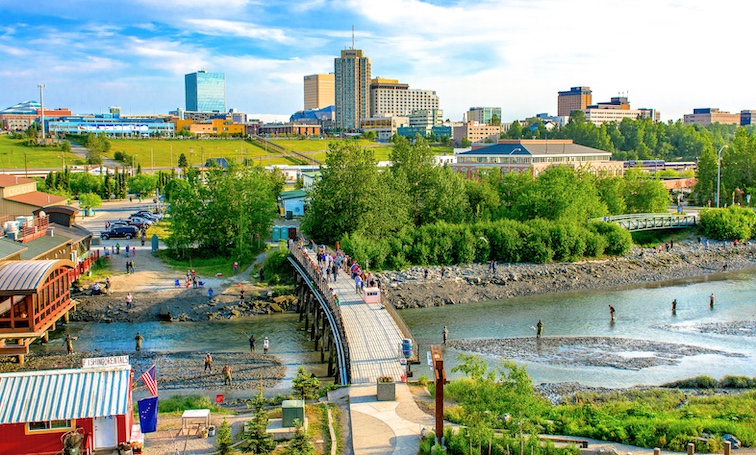
Anchorage residents and visitors can fish for king salmon from mid-May to mid-July right next to downtown in the city’s Ship Creek. The creek’s adjacent Bait Shack (lower-left corner of the picture) provides tackle for visitors and will clean and pack your catch to take home. Photo by Frank Flavin, courtesy Anchorage Convention & Visitors Bureau
Multi-day fishing journeys are available at dozens of remote lodges reached by boat or floatplane, from rustic camps up to luxury complexes where non-fishing spouses may indulge themselves in the resort spa while their partner brings home the bacon. Yes, there is salmon bacon, made from smoked fish belly, just like porcine bacon. Lodge guides will expertly clean and filet the fish, and it’ll be on your dinner plate that evening, or packed in a cooler to take home. It’s a common sight in the Ketchikan, Sitka and Juneau airports to see visitors heading back down to the Lower 48 with a dozen freezer boxes of salmon and/or halibut.
One thing visitors cannot do is enjoy a privilege only Alaska residents enjoy: An annual salmon subsistence harvest with which thousands of households fill their freezers for winter. Each resident is entitled to a set number of salmon, ranging from 25 and up, depending on the location. Unlike recreational fishing, subsistence harvest allows the use of nets, a practice that’s both incredibly productive and incredibly arduous. Most residents schedule a long weekend during July’s near-total daylight.
“This ain’t kick-back, crack-a-beer, and watch-your-bobber fishing,” explains Fairbanks resident Jerry Evans, who treks each year to the upper Copper River at Chitina for his subsistence run. “This is 8 to 12 hours of always-a-pole-in-the-water, start-cramping-in-the-first-couple-of-hours-and-work-your-way-through-it fishing.
Stocking Up for Winter
“Leave Fairbanks at 2 or 3 a.m., drive six hours, get your pole in the water, fish until you limit out, then drive another six-plus hours back to Fairbanks—usually rolling in somewhere between midnight and 3 a.m. It’s a whirlwind 24 hours. But it’s worth every minute to fill a dedicated freezer with 35 to 45 Copper River reds to last the winter,” Evans enthuses.
“It’s the healthiest meat you can eat, and we use it every way you can imagine. Freeze the raw fillets, smoke some, or turn a few into lox. Some are old, established recipes; others you just get creative. Salmon chowder, salmon enchilada soup, salmon patties, salmon cioppino, salmon chili, salmon poké—you name it.
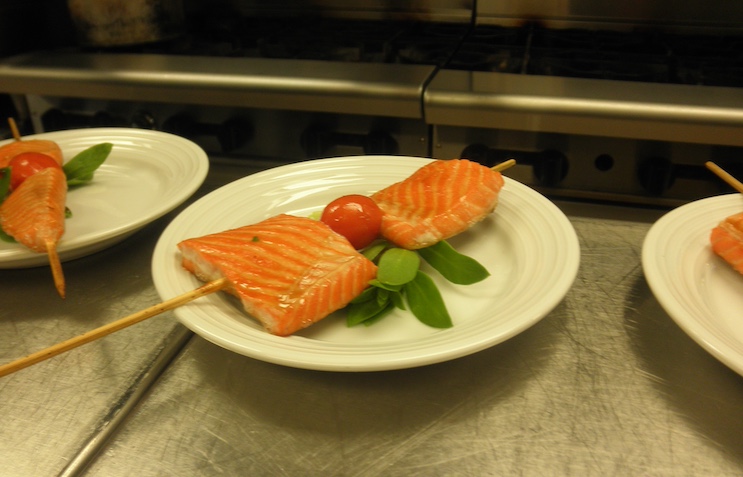
Often discarded by chefs as they prepare salmon for cooking, salmon belly, which has high levels of fat, makes a superb appetizer, as in this dish at Kenai Fjords Wilderness Lodge. near Seward. Alaska bears, looking to fatten up for winter, sometimes eat only the salmon belly and discard the rest of the fish. Here, the salmon is accompanied by beach greens, a tangy native salad herb. Photo courtesy Kenai Fjords Wilderness Lodge
A whole winter of wild salmon to eat—just as Alaska Natives have enjoyed for thousands of years. This is how deeply salmon are embedded in the Alaska psyche. With up to a billion wild fish and billions more hatchery-raised fish, it brings to mind former U.S. Senator Everett Dirksen’s famous aphorism: A billion here, a billion there, pretty soon you’re talking about real money.
In Alaska, it’s real money. The vast majority of wild salmon caught and sold to global consumers originates in Alaska, where this amazing fish is an economic mainstay. Add in the other Alaska fish and shellfish and the state’s seafood industry brings in about $6 billion, which is about 11 percent of the state’s GDP. By comparison, the next two states, Massachusetts and Maine (think lobster) produce about a tenth as much seafood dollar volume as Alaska. The fate of their only salmon, Atlantic, illustrates why Alaskans take theirs so seriously: Only a few small salmon runs cling to life in northern Maine. The rest have been wiped out by dams, pollution and overfishing.
Alaska recreational fishing adds millions more dollars in revenue, and the grand total is likely 10 percent of the state’s economy. Commercial fisherman is one of Alaska’s most respected professions, and these days that includes quite a few women, who cheerfully tell you they are better at their jobs because they are wiser and safer practitioners of one of the world’s more dangerous trades.
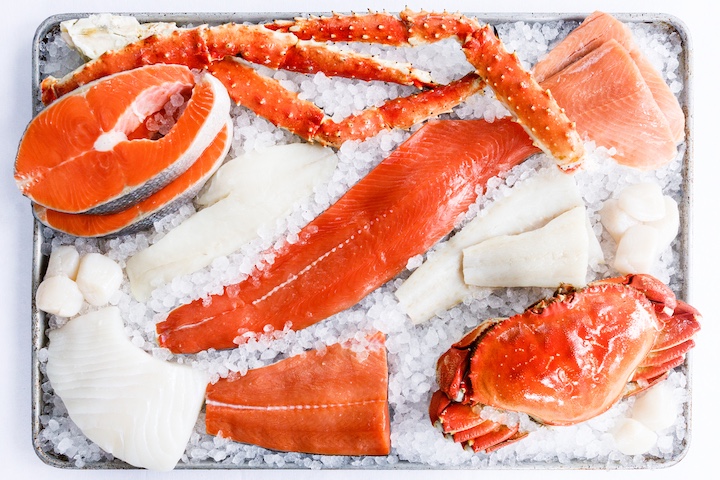
While crabs, scallops, and whitefish such as halibut and sablefish are all part of the Alaska seafood bounty, salmon are the foundation, with the four major types—king. silver, sockeye and pink—represented here in the forms they are usually cooked, filets or steaks. Photo courtesy Alaska Seafood Marketing Institute
With all this salmon reverence, there is one major type of salmon you will never find in Alaska—farm-raised fish. Fish farming is illegal in the state, and while there’s no law that specifically prohibits eating it, you’d have better luck finding moon rocks than farmed salmon.
Soylent Green Now Salmon-Colored
Equally offensive to Alaskans is the recent introduction of artificial salmon, which is “cultivated” in brewery tanks using cells harvested from real Pacific salmon. Grown like bacteria, the meat-like substance is modified with unspecified plant ingredients to produce something resembling sashimi. Promoters claim this “salmon” is healthy and sustainable, but Alaskans don’t buy that. “Sounds creepy,” scoffs Melanie Brown. “Disgusting,” agrees Midgi Moore, owner of Juneau Food Tours and a lifelong wild seafood advocate.
Meanwhile, the debate over the best salmon variety continues. Not only are there five species, but there are innumerable home watersheds—Taku River in Southeast, Copper River and Kenai River in Southcentral, Bristol Bay in the southwest, and Yukon River up north. Each source has its advocates for different species; ask a random Alaskan, and they may say a Taku River sockeye is best, while a Yukon king is best.
If you want to start a bar fight in an Alaska tavern named “Pioneer” (there are many) just shout loudly: “Copper River sockeye are the best salmon,” and head for the door.
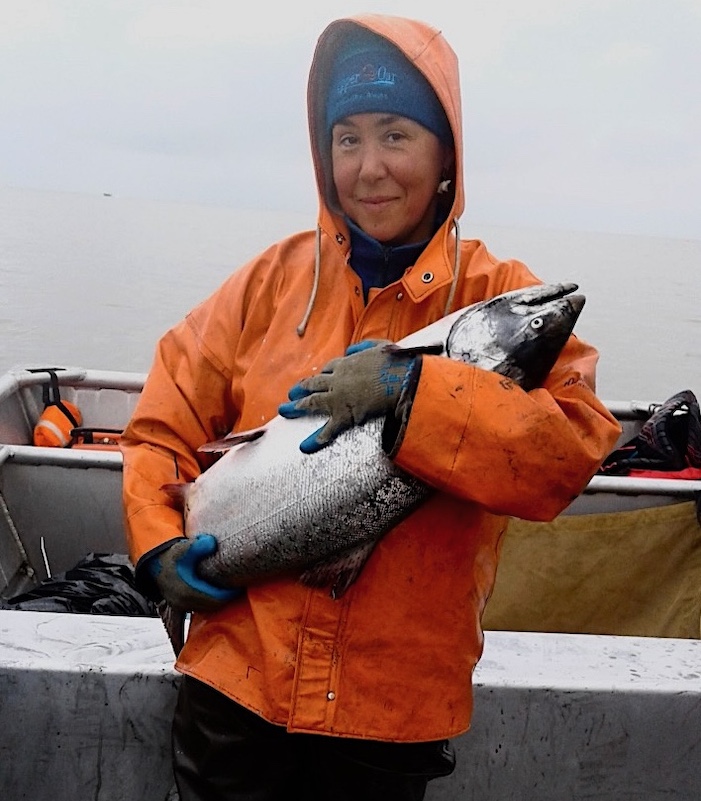
Bristol Bay fisherman Melanie Brown, a Native Alaskan, is fond of the salmon she catches (this is a king) for both cultural and economic reasons. A fourth-generation commercial fisherman, she is harvesting a food that has fed Alaska’s indigenous peoples for thousands of years—and that, as a conservation activist, she hopes will continue to feed Alaskans and seafood fans around the world for centuries to come. Photo courtesy of Melanie Brown
Once, years ago, at a salmon conservation dinner in Juneau, I was seated at a table with six commercial fishermen, all women. I broached the touchy topic of the best salmon, and the result was a tie: three votes for king, three for sockeye.
“Well, Eric, looks like you’ll have to break the tie,” Melanie Brown announced archly.
So what did I say about this dangerous choice? My attorney advises me to demur.![]()
Eric Lucas, author of the Michelin guide to Alaska, lives on a small farm on an island north of Seattle. His previous story for EWNS captured the charm of Fairbanks, Alaska in winter.

